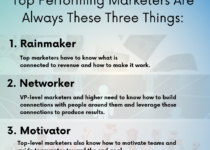Google AI Overviews: Optimization Guide for Marketers
Google’s AI Overviews now represent one of the most significant shifts in how search results are presented to users. As these AI-generated summaries become increasingly prevalent across various industries, marketers must adapt their strategies to maintain visibility and drive traffic in this new search paradigm. This comprehensive guide explores what Google AI Overviews are, how they’re reshaping search, and the specific tactics marketers can implement to optimize for this new feature.
Key Takeaways
- Google AI Overviews appear in 52% of searches as of early 2025, fundamentally changing how users interact with search results
- AI Overviews have grown dramatically in entertainment (528%), restaurant (387%), and travel (381%) industries during recent updates
- Pages ranking in the top 10 organic results are significantly more likely to be featured in AI Overviews
- Content optimized for E-E-A-T (Experience, Expertise, Authoritativeness, Trustworthiness) has higher chances of inclusion
- Structured data implementation helps Google better understand and feature your content
- Entity-driven optimization and comprehensive topic clusters increase visibility in AI-generated results
- Traditional SEO best practices remain foundational but must be enhanced with AI-specific strategies
- Content that directly answers user questions in a conversational, authoritative manner performs best
TABLE OF CONTENTS:
What Are Google AI Overviews?
Google AI Overviews represent a fundamental evolution in search, using sophisticated artificial intelligence to create concise summaries that appear directly on search results pages. Rather than simply presenting a list of links, Google now synthesizes information from multiple sources to provide users with immediate, comprehensive answers to their queries.
The system works through a process called retrieval-augmented generation (RAG), which differs from traditional large language models (LLMs) by dynamically retrieving supplemental information rather than relying solely on static training data. This allows Google to create more current, accurate, and conversational responses that directly address user queries.
“Google AI Overview, a major advancement of the search experience, uses sophisticated artificial intelligence to create brief summaries and answers right on the search results page,” explains digital marketing expert David Miller. “Rather than merely offering a list of links, Google seeks to give users instant, synthesized information based on its interpretation of the query.”
These AI-generated summaries typically include 6-10 links to external sources, with an average length of about 175 words. This format fundamentally changes how users interact with search results, as they can now get comprehensive information without clicking through to multiple websites.
The Impact on Search Behavior and Traffic
The introduction of AI Overviews has significantly altered user search behavior. Instead of clicking multiple links to gather information, users now receive comprehensive summaries without pressing a button. This shift has two major implications for marketers:
- Traffic redistribution: Pages featured in AI Overviews often see increased traffic, while non-featured pages may experience declining visibility.
- Changed engagement patterns: Users may satisfy their informational needs directly in search results without visiting websites, particularly for simple queries.
According to research from Terakeet, AI Overviews now appear on search engine results pages (SERPs) for 52% of tracked searches as of February 2025. This widespread adoption means marketers must adapt their strategies to maintain visibility in this new search environment.
The impact varies significantly by industry. During the March 2025 core update, BrightEdge data showed dramatic growth in AI Overview appearances:
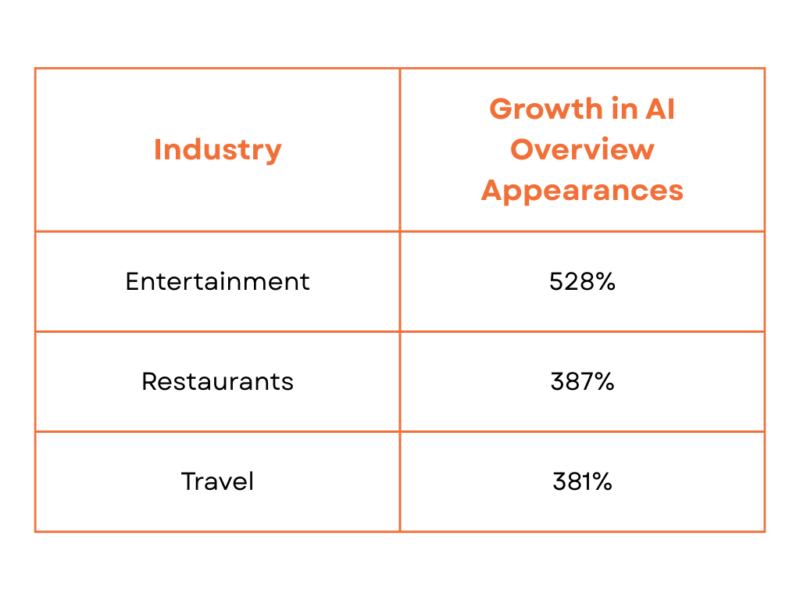
This surge is particularly notable because these industries previously had fewer AI Overviews compared to sectors like healthcare and education. If you’re operating in these rapidly changing verticals, monitoring your keywords for AI Overview appearances is now essential.
Key Factors Influencing AI Overview Inclusion

Research into Google’s AI Overviews has revealed several factors that influence whether your content gets featured:
1. Organic Ranking Position
Pages already ranking well in organic search results have a significant advantage. According to multiple studies, websites appearing in the top 10 organic positions are much more likely to be featured in AI Overviews. This reinforces the importance of traditional SEO as a foundation for AI search visibility.
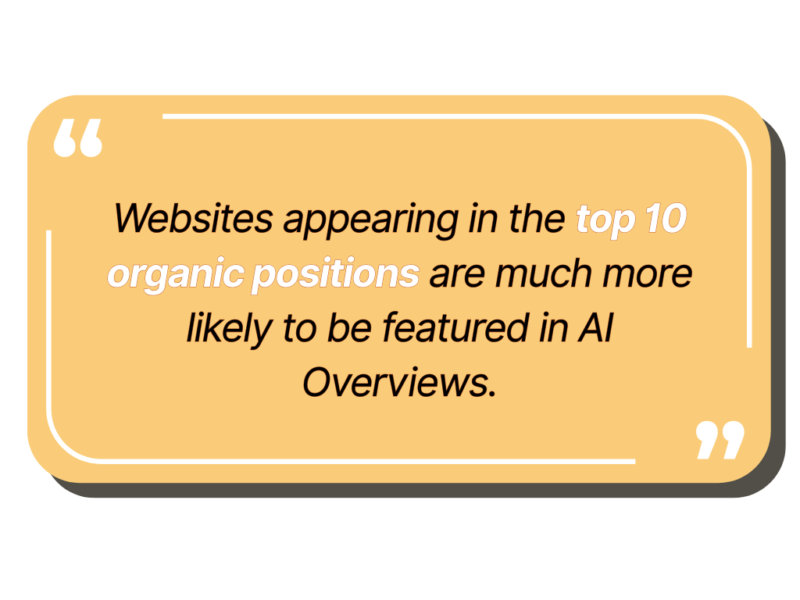
2. Content Quality and E-E-A-T
Google’s AI strongly favors content that demonstrates Experience, Expertise, Authoritativeness, and Trustworthiness (E-E-A-T). This means:
- Content should be created by demonstrable experts in the field
- Information should be accurate, well-researched, and properly cited
- Content should provide genuine value rather than simply targeting keywords
- Websites should have established credibility in their niche
3. Direct Question Answering
Content that directly addresses user questions in a clear, concise manner performs better in AI Overviews. This aligns with the feature’s purpose of providing immediate answers to user queries.
4. Comprehensive Topic Coverage
Rather than focusing on isolated keywords, content that covers topics comprehensively through interconnected clusters has higher chances of inclusion. This approach signals to Google that your content provides thorough information on the subject.
5. Structured Data Implementation
While basic HTML formatting doesn’t seem to correlate with inclusion, proper structured data markup helps Google better understand your content’s context and meaning, potentially increasing its chances of being featured.
Optimization Strategies for Google AI Overviews
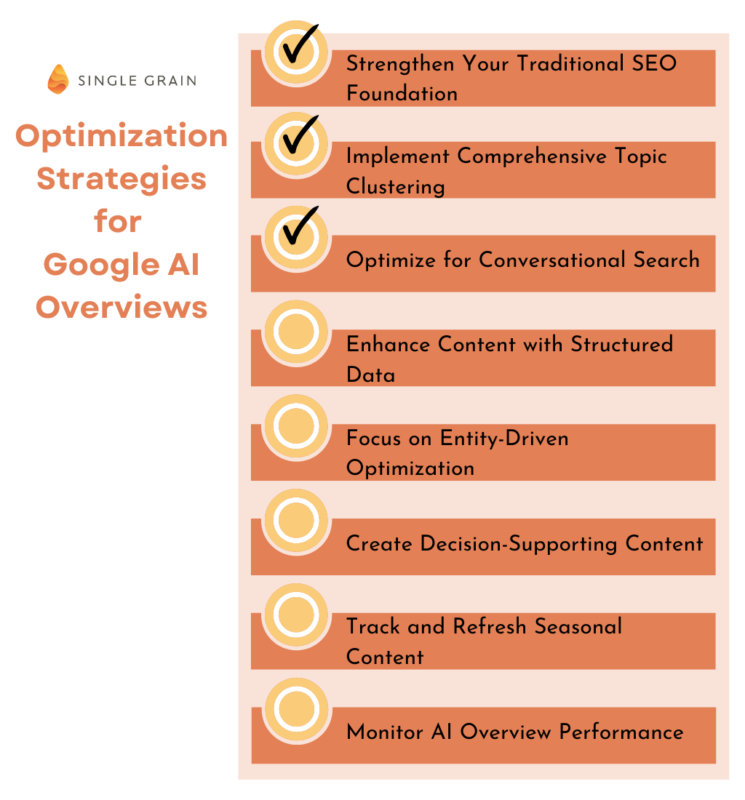
Based on these influencing factors, here are specific strategies marketers can implement to optimize for Google AI Overviews:
1. Strengthen Your Traditional SEO Foundation
Since organic ranking position strongly correlates with AI Overview inclusion, maintaining solid SEO fundamentals remains crucial:
- Conduct thorough keyword research focusing on user intent
- Create high-quality, original content that satisfies search intent
- Optimize technical aspects like site speed and Core Web Vitals
- Build authoritative backlinks from reputable sources
- Ensure mobile-friendliness and excellent user experience
Single Grain’s SEO services can help you build this strong foundation that serves as the entry point for AI Overview visibility.
2. Implement Comprehensive Topic Clustering
Rather than creating isolated pieces of content, develop interconnected topic clusters that demonstrate comprehensive coverage:
- Identify core topics relevant to your business
- Create pillar content that broadly covers each topic
- Develop supporting content that addresses specific aspects in detail
- Link these pieces together in a logical hierarchy
- Update content regularly to maintain freshness and relevance
This approach not only improves your chances of appearing in AI Overviews but also enhances your overall search visibility by establishing topical authority.
3. Optimize for Conversational Search
With the rise of voice search and natural language queries, users increasingly interact with search engines conversationally. To align with this trend:
- Research and target long-tail, question-based keywords
- Structure content to directly answer common questions
- Use natural language that matches how people actually speak
- Implement FAQ sections with concise, informative answers
- Consider the context and follow-up questions users might have
4. Enhance Content with Structured Data
Structured data markup provides explicit clues about your content’s meaning:
- Implement Schema.org vocabulary appropriate to your content type
- Use FAQ, HowTo, and other relevant schema types
- Ensure accurate implementation through testing tools
- Keep structured data updated as content changes
- Consider advanced implementations like Dataset schema for research-based content
This markup helps Google’s AI better understand the entities and relationships on your site, making your information more likely to be included in AI Overviews.
5. Focus on Entity-Driven Optimization
Google’s AI increasingly understands content through entities (people, places, things, concepts) rather than just keywords:
- Identify and incorporate relevant entities in your content
- Create clear associations between related entities
- Build entity authority through consistent, accurate information
- Use unambiguous language when referring to entities
- Consider creating dedicated content for important entities in your niche
This approach aligns with how Google’s AI interprets and synthesizes information for Overviews.
6. Create Decision-Supporting Content
According to BrightEdge’s Jim Yu, marketers should “create content that supports decision-making, including activities and ideas for things to do.” This is particularly important in industries seeing rapid growth in AI Overviews, such as entertainment, restaurants, and travel.
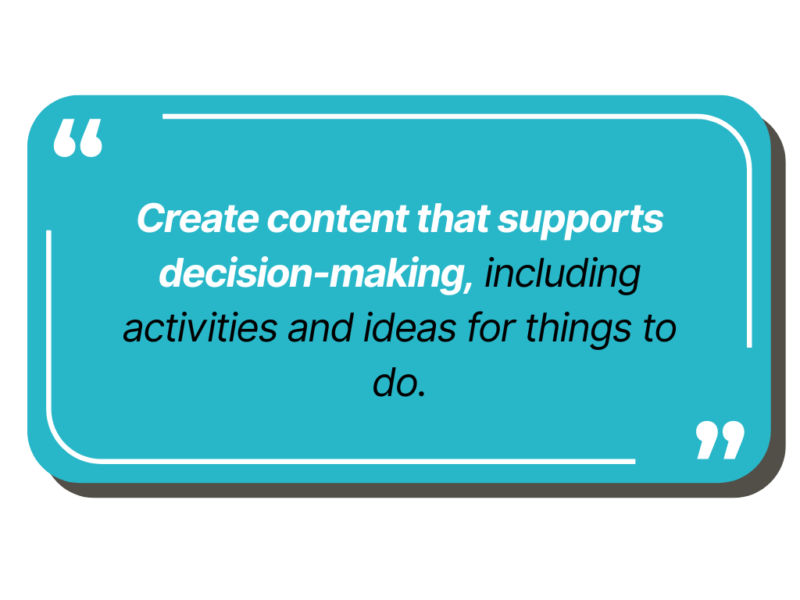
Content that helps users make decisions rather than simply providing information is more likely to be featured and clicked on, even when appearing within AI Overviews.
7. Track and Refresh Seasonal Content
Seasonal trends significantly impact search behavior, especially in industries like travel and entertainment. Regularly updating content to match shifting seasonal interests ensures your information remains relevant and worthy of inclusion in AI Overviews.
This might involve:
- Creating editorial calendars aligned with seasonal trends
- Updating existing content with fresh information
- Developing new content to address emerging seasonal queries
- Monitoring performance to identify seasonal patterns
8. Monitor AI Overview Performance
Unlike traditional ranking reports that focus on blue links, marketers now need to track their visibility within AI Overviews:
- Identify which queries trigger AI Overviews in your industry
- Monitor which of your pages are referenced in these summaries
- Track click-through rates when your content is featured
- Analyze patterns in the types of content that get included
- Compare traffic before and after AI Overview appearances
Several SEO tools are beginning to incorporate AI Overview tracking, making this process more manageable.
Industry-Specific Optimization Tactics
Different industries require tailored approaches to maximize visibility in AI Overviews:
Entertainment Industry
With a 528% increase in AI Overviews, entertainment marketers should:
- Optimize for entity-driven searches around celebrities, movies, shows, and events
- Create comprehensive guides that answer common questions about entertainment properties
- Develop content that helps users make entertainment choices
- Implement structured data specific to creative works, events, and people
Restaurant and Food Industry
Restaurants have seen a 387% increase in AI Overviews and should focus on:
- Creating location-specific content that addresses “near me” searches
- Developing comprehensive guides to local dining scenes
- Optimizing for specific food types and dining experiences
- Implementing restaurant-specific schema markup
- Creating content that helps diners make decisions based on occasion, dietary needs, etc.
Travel Industry
With a 381% increase in AI Overviews, travel marketers should:
- Create comprehensive destination guides that answer common traveler questions
- Develop “things to do” content for popular destinations
- Optimize for seasonal travel trends with regularly updated content
- Implement location and event schema markup
- Create content that supports travel planning and decision-making
Measuring Success in the AI Overview Era

Traditional SEO metrics remain important but must be supplemented with new measurements that reflect the changing search landscape:
1. AI Overview Inclusion Rate
Track the percentage of your target keywords that trigger AI Overviews and what percentage of those include your content. This indicates your visibility in this new search format.
2. Featured Source Position
When your content is included in AI Overviews, note its position among the featured sources. Earlier mentions typically receive more attention and clicks.
3. Post-Overview Traffic Analysis
Compare traffic patterns before and after your content begins appearing in AI Overviews. Some pages may see increased traffic, while others might experience declines.
4. Conversion Impact Assessment
Analyze how traffic from AI Overviews converts compared to traditional search traffic. This helps determine the quality of these new visitors.
5. Brand Mention Monitoring
Track how your brand is represented in AI Overviews, even when your specific content isn’t linked. This affects brand perception and recognition.
The Future of AI Search Optimization
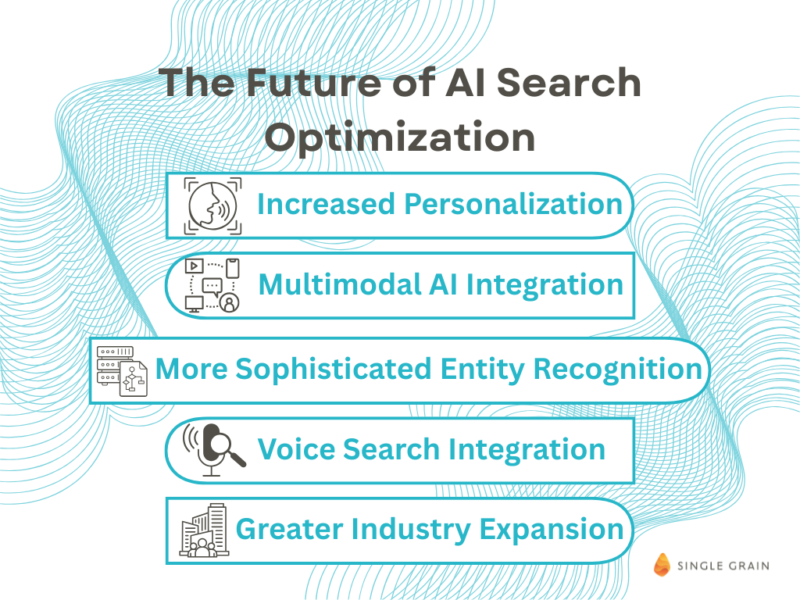
As we look ahead, several trends will likely shape the future of optimization for AI-driven search:
1. Increased Personalization
Google’s AI will likely become more sophisticated in tailoring Overviews to individual users based on their search history, location, and preferences. This will require marketers to create more versatile content relevant across multiple contexts.
2. Multimodal AI Integration
Future iterations of AI Overviews may incorporate more visual and audio elements, requiring marketers to optimize multimedia content for AI understanding.
3. More Sophisticated Entity Recognition
As Google’s entity recognition capabilities advance, creating content with clear entity relationships and building entity authority will become increasingly important.
4. Voice Search Integration
The convergence of AI Overviews with voice search will further emphasize the need for conversational content that directly answers user questions.
5. Greater Industry Expansion
While certain industries have seen dramatic growth in AI Overview appearances, we can expect this feature to expand across more sectors, requiring all marketers to adapt their strategies.
Adapting to the New Search Reality
Google’s AI Overviews represent a fundamental shift in how users interact with search results. This change requires a strategic marketing evolution rather than a complete reinvention of SEO practices.
By building on traditional SEO foundations while implementing AI-specific optimizations like structured data, entity optimization, and comprehensive topic clustering, brands can maintain and improve their visibility in this new search landscape.
The most successful marketers will be those who view AI Overviews not as a threat but as an opportunity to demonstrate their expertise and provide genuine value to users seeking information. By creating authoritative, user-focused content that directly addresses search intent, brands can position themselves for success in the evolving world of AI-driven search.
Ready to optimize your content for Google’s AI Overviews? Contact Single Grain’s SEO experts to develop a customized strategy that ensures your brand remains visible and influential in the age of AI search.
Related Video
The post Google AI Overviews: Optimization Guide for Marketers appeared first on Single Grain.

